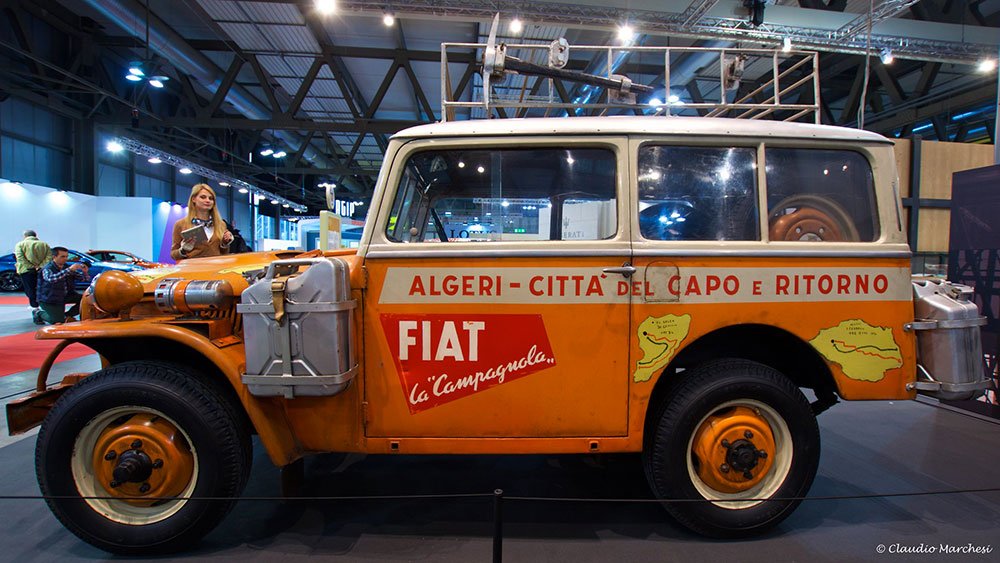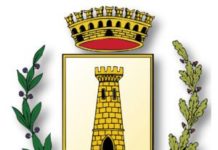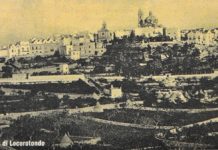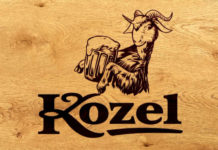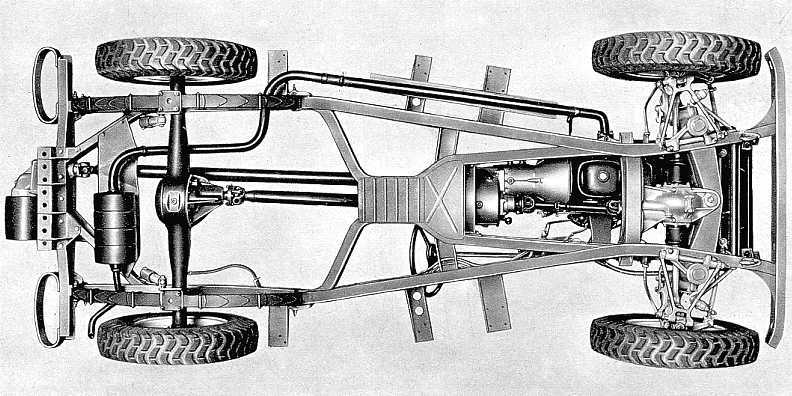
Everything can talk about Territory and Tourism
Car and Tourism Promotion
As presented in a previous article, we presented the extreme connection between advertising places and tourist spots and how one can have a showcase of notoriety and business opportunities with a few euros or, even, for free .
In this case, we talked about it in this article Grant Tourism 7 and the tourism promotion of Alberobello ( Apulia ). Read it , it is interesting.
But, picking up on this concept: did you know that the omnipresent Fiat Campagnola was unveiled at the Fiera del Levante in Bari in 1951; an edition that saw an Italy bent by World War II, but, ready to rise with an indomitable dignity.
The Fiat Campagnola itself , was intended to be a test of how a defeated state could build a military and civilian vehicle with features equal to, if not superior to, the U.S. Jeep Willys.
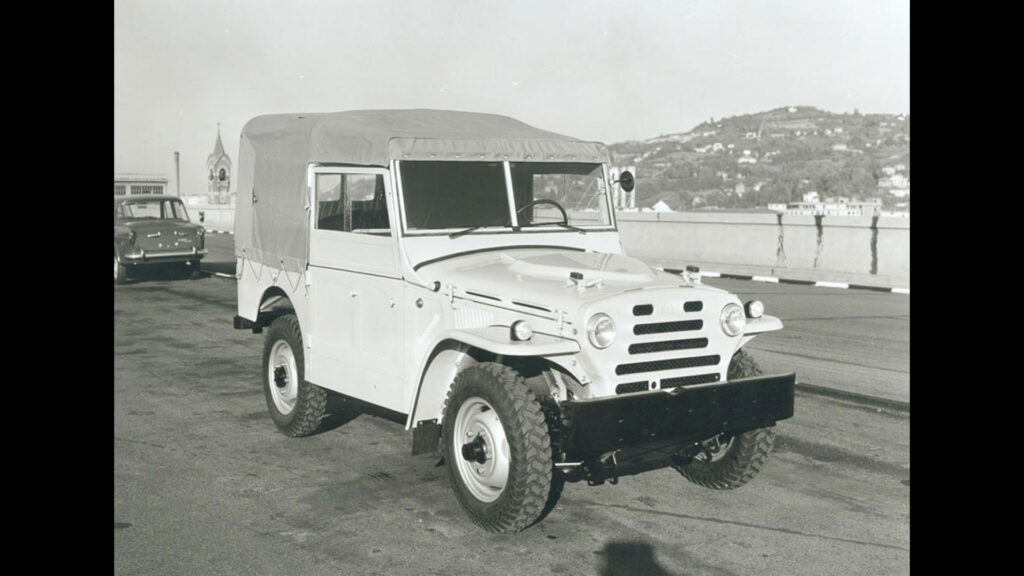

The Fiat Campagnola is remembered by all of Us during Military Service, when on the roads of our encampment barracks we had to defend ourselves from any attempted “investment” by careless fellow soldiers driving them. Personally, I remember very fondly the filled shed at the Trani military barracks of immobile and dismounted V.M.’s who had as their only nurses Fiat Campagnole type II and even I ; those, yes, never stopped .
We Eat Air . Meat from CARBONIC ANHYDRIDE
PANE and FOCACCE from Puglia ( Italy) – the Illustrious Past.
San Rocco and breast-shaped gifts
Biodiverse Tourism: carrots from Polignano and Tiggiano in Puglia
Fiat Campagnola AR51 History
Also known as the AR51 model, the first generation of the off-road Fiat Campagnola was born for military use and was also produced for civilian use until 1973
In the summer of 1951, production of the Fiat Campagnola began at the Lingotto plant in Turin, Italy, and it was officially unveiled at the Fiera del Levante in Bari the following September. The Turin-based manufacturer designed this off-road vehicle to win the Ministry of Defense’s call for tenders, published in November 1950. The Fiat Campagnola won the tender, which included the purchase of 6,000 ‘little trucks’ by the state, due to its lower cost than the competing Alfa Romeo 1900M ‘Matta’. Initially, Fiat had planned to produce the U.S.-based Willys ‘Jeep’ under license, at its subsidiary Simca in France. However, Dante Giacosa’s 1101 design was preferred, as it shared much of the mechanicals with the 1100, 1400 and 1900 models. The initial name, however, was Alpina, but then the title of Carlo Buti’s song of the same name was preferred.
The main features of the Fiat Campagnola – also known in military circles as AR51 (an acronym for 1951 Reconnaissance Motor Vehicle) – were the ‘torpedo’ bodywork with forward folding windshield, two front seats, two rear longitudinal benches for four seats, 500 kg load capacity, tarpaulin cover and constant velocity joints. Aesthetically, the ‘automotive’ declination of the Fiat Campagnola, on sale at a base price of 1,600,000 liras, was recognizable by its hinged rear door at the bottom, higher cover with celluloid side windows, and rear benches that were upholstered as well as equipped with backrests. In terms of dimensions, it was 364 cm long, 148 cm wide and 195 cm high, while the wheelbase measured 225 cm. The Fiat Campagnola was equipped with the 1900 four-cylinder ‘rods and rockers’ gasoline engine with 53 hp of power and a top speed of 100 km/h, combined with a four-speed manual transmission with a gearbox. The rest of the mechanicals included all-wheel drive that could be engaged only in reduced gears, automatic rear differential lock, and a spar chassis with box-sheet cross members.
In addition, the Fiat Campagnola was equipped with independent front suspension with coil springs, transverse stabilizer bar, and oil-bath hydraulic shock absorbers, while the rear was composed of the rigid axle rear suspension with leaf springs and telescopic shock absorbers. In 1953, the range was expanded to the declination with the 1900 Diesel engine with 40 hp of power and 85 km/h top speed, offered at a base price of 1.8 million liras. At the same time, the aesthetics were slightly updated and the independent control for insertable four-wheel drive was installed.
In 1955 the second series of the Fiat Campagnola, also known as Campagnola A or AR55, debuted. The cosmetic makeover included a redesigned front bumper, modified headlights, a heater system included as standard equipment, and a manual rear differential lock. However, the biggest change was the upgraded engines, with the 1900 gasoline powerplant with 63 hp of power and 116 km/h top speed and the 1900 Diesel engine with 43 hp. The Fiat Campagnola was updated again in 1959, when it adopted modified headlights to comply with the Highway Code. The related military version also adopted the AR59 badge and upgraded electrical system. In 1960 the Campagnola B was introduced with the 1900 Diesel engine with 47 hp of power and 95 km/h top speed, then replaced – in 1968 – by the Campagnola C, which included the Bosch rotary pump injection system and the electrical system with the alternator instead of the dynamo. The exit of the Fiat Campagnola was in 1973, when it ended production after 39,076 examples, of which 7,783 were in the declination with the diesel engine.
The entrance to the barracks
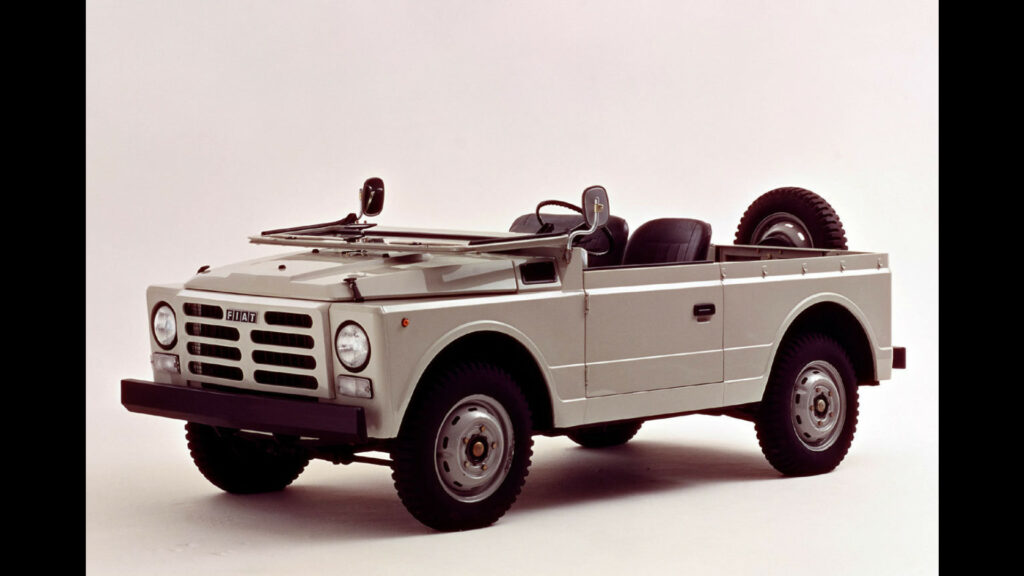

The crew consisted of four military personnel on the rear benches, the chief engineer, and the conductor.
The transmission was a 4-speed with creeper gears and only II, III and IV synchronized. The rear differential was lockable with a safety sleeve that in case of failure to disengage, in the curves broke specially safeguarding the mechanics. I wonder how many were changed?
116 km/h was the top speed, but enthusiasts, as you can guess, confirm to me that it became almost unrideable given its weight, drum brakes and “country” rather than street nature.
24-volt power supply and 12 volts for the civilian series made this “lady” a great climber of meadows, hills and mule tracks, and even muddy terrain did not betray her specialty. Fords, if the water did not reach the level of the batteries placed under the seats, were safely traversable even if the steering became very heavy
But let’s get to the more “recent” memories: the ’76 restyling
The new AR 76 completely redesigned and thus no longer an Italian copy of the valid Willys, began to enter the barracks in the 1980s bringing with it more or less the same technical operational characteristics that characterized the AR51 design, which was already very good anyway.
I really have many memories related to the AR76 being from the class of ’70. Let’s look at some technical details together before moving on to departmental uses.
The powerplant was increased to 1995 cc, an engine destined to set the standard in Fiat models; it delivered only 80 horsepower and the first series had 4 gears later changed to 5, with always the option of using the lever to shift to low gears.
Two aluminum T-levers (remember them?) were one for locking the rear differential and the other for switching to front-wheel drive, which could be done even with the vehicle in motion.
A success and an Italian reference that in Eastern countries was produced under the name Zastava. It participated in the Paris Dakar in ’82 with a 200 hp Lancia Stratos V6 engine.
The boom of the 1980s also bore the name of the “Campagnola,” in fact its fittings as well as for the Armed Forces and institutions were appreciated by municipalities for the tow truck and snowplow version but also by Enel and Agip for drilling artesian wells.
The long-wheelbase hard top version was sometimes outfitted as an ambulance, while the 2,500 turbodiesel versions were often intended for firefighters and police, the latter of which even had a few in armored versions.
The 4×4 Popemobile
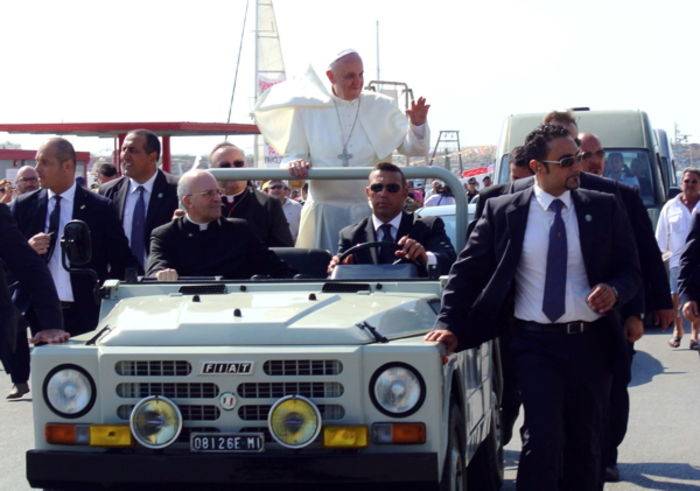

In addition to the merits, there were also some flaws….
In fact, its limitation in off-roading was mainly attributable to the limited travel of its independent-wheel suspension, whereas the historic Willys had a rigid axle that was clearly much more adaptable to extreme terrain.
Other noteworthy problems with the AR76 were the crosses of the transmission joints, which, by virtue of their inclination, sheared easily, but also the drum brakes, which, when wet, stretched the stopping distances quite a bit considering its 1700-pound mass.
The occupants on the 76 version, had increased to 7 due to the split front seat for the foreman, who also had to sit near the window at all times for the beret salute.
On the road it traveled miles without a problem even though cold starting made it jump for the first quarter of an hour: the cooling fan was in fact fixed to the rotation of the engine.
It had a tendency to oversteer especially on low-grip surfaces, but it controlled itself quite well with due care not to release the throttle. Otherwise it would close on the front end by going sideways.
A Browning or Mg machine gun but also radio structures such as Pr5 and RW4 stations and so on could be attached to the green, rolled tarp structure.
Conclusions A.I.LoveTourism
What do we take home from this article?
We presented the history of one of the most iconic motor vehicles for our Republic. All of Us associate the Fiat Campagnola with an event of our Past, because it has been used in a thousand civilian and military fields and, even by chance, we have seen one on the road or, even, it has been of great help in precipitous situations.
We can, now, associate its birth with Bari itself and use this information to publicize and tell about our area. One more weapon to connect passion for travel with passion for motors or industrial history and, why not, we could also talk about Bari’s Fiera del Levante itself…
This, is our way of working, linking historical factors and tales of the area by deriving more and more keys to understanding their origins and motives.
Follow us on the official website to understand how our Journeys/Stories work.
via Ammiraglio Millo 9 .
Alberobello, Bari.
📞 +39 339 5856822

